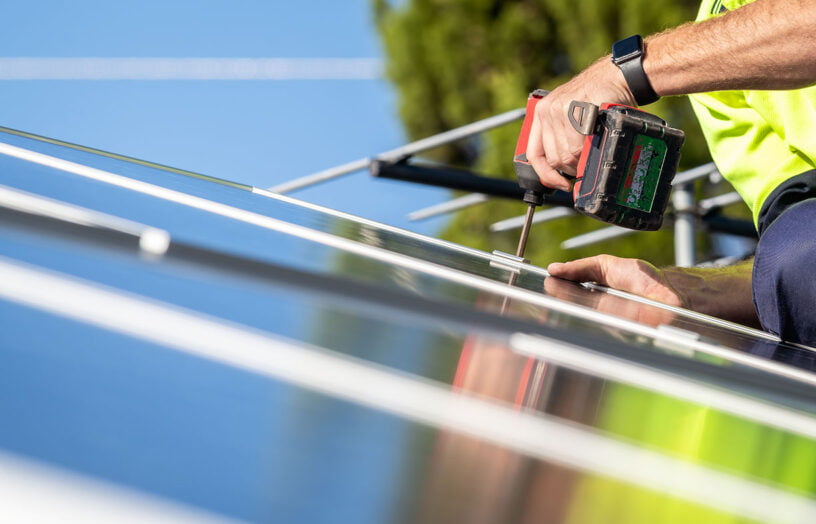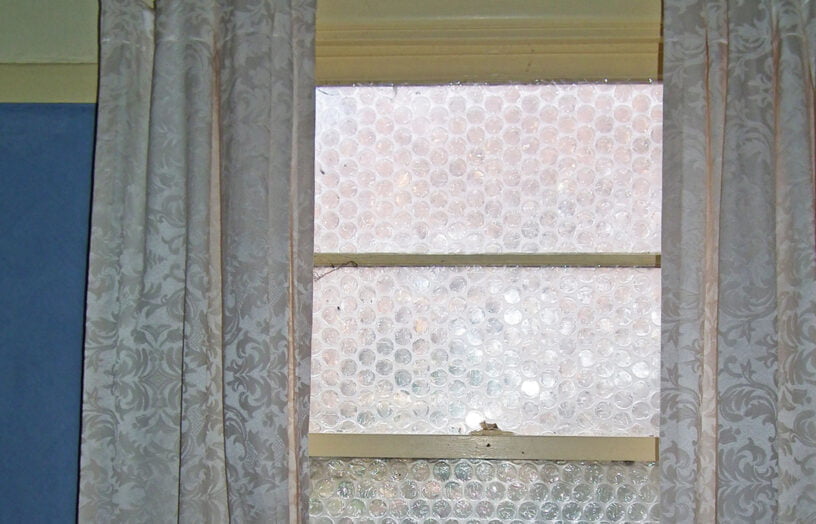Remote communities leading the charge

Bala balas: low-energy buildings in remote Australia
Over the past seven years, builder/carpenter Strath Barton has built relationships with NGOs in West Arhnem Land. Together, they’ve developed and refined a fit-for-purpose, pre-fabricated accommodation structure produced in Darwin and installed onsite. He tells us more.
The buildings I’ve been working on with communities in West Arnhem Land are called bala balas, a term which refers to a traditional bark shade structure. They have evolved to feature a canvas tarp shade, and what we’ve been working on more recently is a permanent version of those structures—in a new location, closer to the ocean/cyclone zone, which is a very unique setting.
I lived in Maningrida briefly and was approached to build the first accommodation building in 2018. I’ve been coming back to West Arnhem land to work on them since—in both a building and a design capacity. The structures are mostly accommodation for rangers and teaching staff. We’re currently planning a classroom and early learning centre, which will be an adaptation of our current structures to create a comfortable, open-plan learning space for young people.
While working with a community in Mamadewerre, we copied some of the traditional shapes of the tarped bala balas and created these big fly roofs that come right down low over the top of the platforms. That design is very important when you’re dealing with a wet and a dry season, where a lot of the time it’s hot in the middle of the day.
The buildings have no walls—just flyscreens and security screens, so they’ve got maximum airflow. You’re essentially camping within them. There are lights, ceiling fans, a composting loo and shower, as well as a small kitchen with a gas stove. There aren’t many structures in that environment that function without air-conditioning.
When it comes to energy use, many of these smaller outstations rely on a dated solar system with a diesel backup, and often, you’ll arrive in these places and the generators are running full time. In the wet season, the diesel can run out and there’s no way of replenishing it until the roads open. Having a building that doesn’t require a cooling source is key. The groups we work with have put a huge amount of time and money into ensuring these small outstations have reliable power and water.
All the buildings in Mamadewerre are now attached to a new solar hybrid system with a lithium battery bank (specs below) that was installed in 2021. This currently runs four bala balas, a school with air-conditioning, a mechanical workshop and a soon-to-be fifth bala bala and air-conditioned classroom.
Solar Hybrid System
- 30kW PV
- 15kW Inverter chargers
- 32kW Solar inverters
- 66kWh Battery storage
- 18kVA Genset
Everything we build out there is being transported from Darwin, so per building, we’re spending about $20,000 on transport. Quite often, buildings in these outstations are made of concrete block and concrete, so the cost is even more immense and the impact it has is huge. That’s why we’ve tried to design the bala balas in Mamadewerre to last a long time and be as light on materials as possible. They’re a steel structure that we prefabricate in Darwin with minimal bells and whistles. We’ve adapted our plans to accommodate standard sizing of flooring and roofing, as well as screening to minimise waste on site.
The logs we use for the tarped structures in Kabulwarnamyo, Manmoyi and a handful of other remote locations (used as remote bases for rangers) are locally harvested cypress (Callitris intratropica) that has died due to fire. We often go out with the local Warddeken rangers and harvest the dead trees—they function quite well. They’re also naturally termite resistant, so they go in the ground and some of them have been there since 2009.
The groups involved in this project included Warddeken Land Management—an indigenous ranger group in West Arhnem Land; Nawarddeken Academy—an independent indigenous school in West Arhnem Land; and Karrkad Kanjdji Trust—a philanthropic trust that helps fund most of these structures.
This is one of several articles on low-energy buildings and renewables in remote Australia in Renew 167. To read the rest, buy the issue!
Further reading
 Efficient homes
Efficient homes
Tradies and the transition
Do we need as many tradies for electrification as many think? Not if we are innovative, writes Alan Pears.
Read more Efficient homes
Efficient homes
Double glazing on the (very) cheap
Do we need as many tradies for electrification as many think? Not if we are innovative, writes Alan Pears.
Read more Efficient homes
Efficient homes
Building for a changing climate
Are we building homes for the future, or for the past? Rob McLeod investigates how climate change is impacting home energy ratings and the way we build our homes.
Read more

